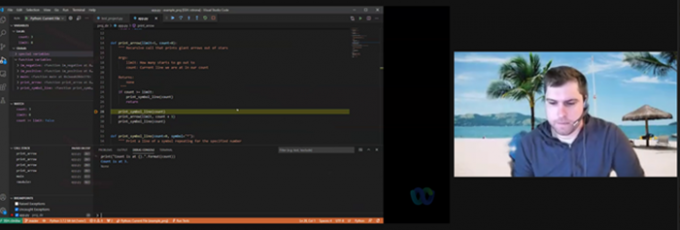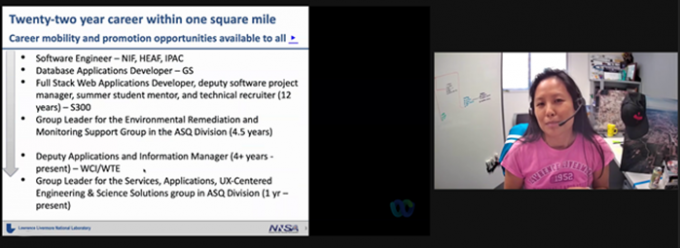Disclaimer: This article is more than two years old. Developments in science and computing happen quickly, and more up-to-date resources on this topic may be available.
For five years, Computing’s annual Developer Day has brought LLNL’s software community together to share best practices and new ideas. On July 15, the event was again held virtually over WebEx. The morning session included lightning talks about productivity tools and “quick takes” on remote-development resources. Ian Lee, who serves as Computing’s alternate Organizational Information System Security Officer, presented a technical deep dive on the Lab’s software supply chain. The afternoon session provided presentations about career paths and the Lab’s diversity and inclusion goals, capped by a career development panel discussion co-sponsored by the Data Science Institute.
“During the pandemic, it has been exceptionally challenging to feel connected with peers across the Lab,” said Kyle Dickerson, who works in the Global Security Computing Applications Division (GS-CAD) and has co-organized every Dev Day. “This was an important opportunity to refresh connections with others and strengthen our community as we begin operating within the new normal.”
Productivity Hacks
Dev Day’s lightning talks—defined as “something cool in tech that you built or discovered”—highlighted Dickerson’s family calendar and weather display powered by Raspberry Pi; computer scientist Mark Miller’s overview of Git worktrees for managing work on multiple branches; software developer Kristi Belcher’s examples of using Clang’s AddressSantizer error detection tool, particularly for memory leaks; and computer scientist Tapasya Patki’s summary of the open-source power management tool Variorum, which helps developers write portable code for different computing architectures.
The event also included short presentations on remote-development resources, such as Joseph Moon’s tips and tricks for using Singularity containerization. Jack Acton demonstrated Visual Studio Code extensions that allow users to work on remote computing systems. (See Figure 1.) “Our work is happening more and more on remote systems, such as when apps run on a high performance cluster instead of the user’s local machine or when machine learning and data science applications need heavy GPU [graphics processing unit] usage,” he explained.
Acton continued, “I like that VS Code is a flexible tool that can morph into the environment you need for the job you are doing. I use it outside of work for 3D printing and micro-controller hobbies.” As a computer scientist on LLNL’s Flight Performance Integration team, which provides expertise and tools for modeling and analyzing vehicles and payload response in a variety flight conditions, Acton signed up for Dev Day because he enjoys sharing interesting work that may help others.
Computational mathematician Julian Andrej presented a productivity improvement implemented by the MFEM development team: automation of the pull request (PR) queue using the GitHub Gopher API. The team came up with the idea during a hackathon, and has since automated most of the PR workflow process. Andrej, who works in LLNL’s Center for Applied Scientific Computing (CASC), explained, “MFEM receives at least one PR every day, and we have to review them all.” The Go backend communicates with GitHub, while a JavaScript front-end provides a dashboard where the team checks PR statuses.
Career Focus
As a forum for developers to discuss and nurture common threads, Dev Day has previously hosted career panels and networking sessions. This year, the entire afternoon was devoted to career-related topics such as how to advance in Computing. Anh Quach, an ASQ group leader, shared wisdom learned over her 22-year Lab career, during which she has held software engineer, developer, and management roles. (See Figure 2.)
“Computer science is a build-your-own adventure,” Quach said. She described a nonlinear path that includes switching college majors, earning an MBA and HRCI Professional in Human Resource certification, serving twice as a Computing group leader, onboarding new employees, and increasing the Lab’s presence at diversity-focused events such as the annual Grace Hopper Celebration. Quach continued, “It’s awe-inspiring to be part of the network of national labs. You don’t need a PhD to work here, and definitely not to advance in Computing.”
Among Quach’s helpful career tips was the advice to “broaden your network and deepen your skills.” She encouraged attendees to be proactive: “Does your manager know you want a lead role? Who is aware of your aspirations? If you see a gap, why not fill it?”
The afternoon continued with a talk by Tony Baylis, LLNL’s director of diversity, equity, and inclusion (DEI). He summarized the Lab’s efforts to foster a culture that embraces DEI and that attracts and retains diverse staff. “Investing in the recruitment and development of our workforce with a focus on enhancing team science are a vital component of our success,” he noted. (See Figure 3.)
Baylis, who formerly served as Computing’s workforce manager, pointed out that everyone can help forge an inclusive and equitable workplace. “This effort will take all of you being part of that journey,” he said. “Computing is a large component of our recruiting activities. Joining employee resource groups and participating in recruiting activities are professional development opportunities.”
Advice from the Panel
Dev Day concluded with a career-focused panel co-sponsored by the Data Science Institute. GS-CAD computer scientist Michael Ward moderated the discussion, which featured four Computing employees at different stages of their careers. (See Figure 4.)
Livermore Computing (LC) computer scientist Todd Gamblin traced his path from college to a dot-com company to graduate school to the Lab. “It’s a weird trajectory,” he said. “I’ve always done a combination of research and practical solutions. Now I work less on performance and more on software research and development.”
National Ignition Facility Computing (NIFC) group leader Kathleen McCandless earned a master’s degree from Stanford University while employed at LLNL. “We have such amazing resources at the Lab for growing people’s skill sets,” she said, noting the many ways employees can expand their education on the job. “Pick a couple of areas you might want to work on and find some opportunities—even a small, week-long class.”
Ward asked the panel how they keep pace with the latest technology in a field that rapidly changes. Angeline Lee, who joined the Lab in 1994 and now serves as an ASQ group leader, pointed out, “There’s no shortage of information out there. The challenge is to filter through it, find out what’s relevant and what might be useful, and not get distracted.”
GS-CAD software developer Tim Nilsen added, “Engaging in the software community and hearing what others are using is a great way to keep up with certain technologies.” For example, he discovered the field of DevSecOps in a GitLab newsletter. Gamblin recommended reading books and listening to software-relevant podcasts, but at some point, he advised, “Stop reading and start implementing.”
Virtual Success
Pandemic restrictions did not dampen Dev Day turnout, as nearly 100 people attended the 2021 event. For Andrej, the online format was convenient. “The talks being virtual made it more attractive for me to attend and to present because the time commitment was flexible,” he stated.
In his closing remarks, Dickerson reflected on the event’s purpose and encouraged others to continue participating. “Dev Day provides the opportunity to hear from people outside of our own bubbles, and I always learn about something new that I had no idea was happening at the Lab,” he pointed out. “Having worked from my closet for the past 16 months, it was nice to see people and engage in some camaraderie. The whole day went very smoothly, and I’m looking forward to an in-person event next year. Everyone has something to share, and there’s always something to learn.”
Along with Dickerson, event organizers were David Beckingsale (CASC) and Geoff Cleary (LC).
—Holly Auten




